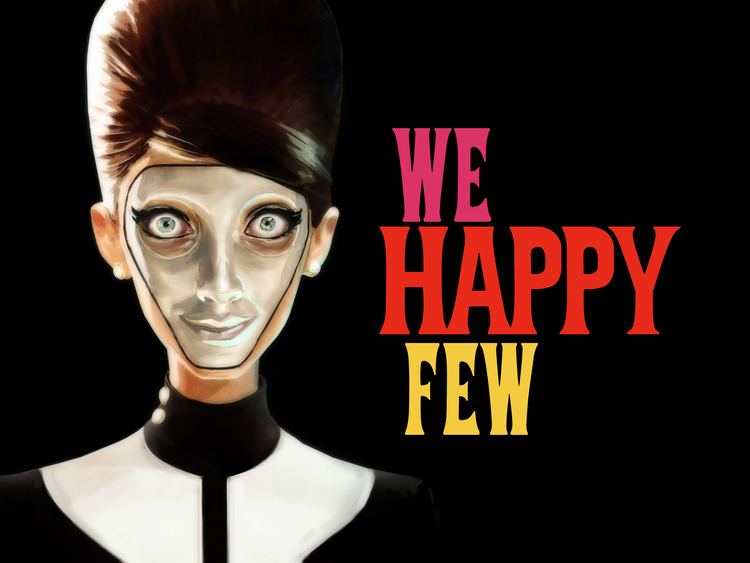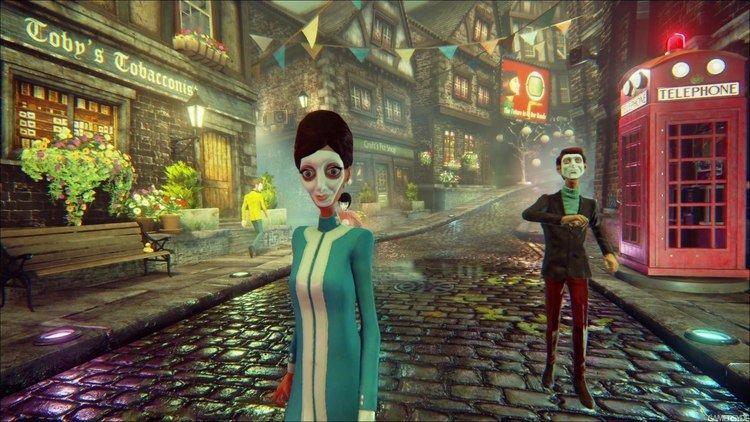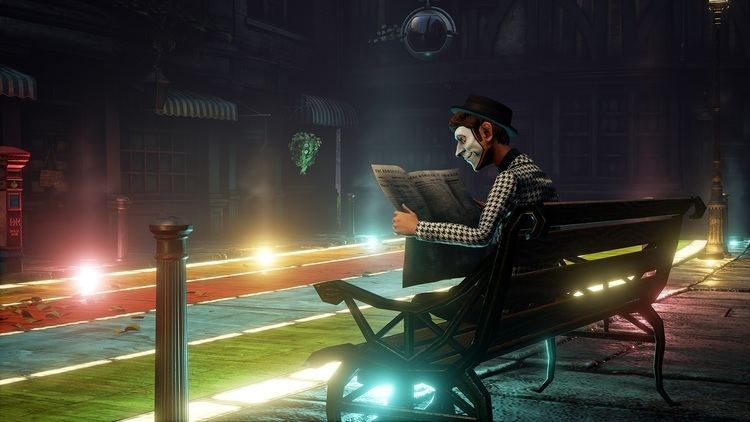9.6 /10 1 Votes
5/5 Microsoft Artist(s) Whitney Clayton Composer(s) Nicolas Marquis Developer Compulsion Games Engine Unreal Engine Publisher Compulsion Games | 9/10 Steam Director(s) Guillaume Provost Writer(s) Alex Epstein Mode(s) Single-player Designer(s) David Sears Genre Survival horror | |||||||||||||||||||||||||||||||||
Platforms Xbox One, Microsoft Windows, Linux, Macintosh operating systems Similar Contrast, Inside, ABZÛ, Layers of Fear, Cuphead | ||||||||||||||||||||||||||||||||||
We Happy Few is an indie survival horror video game being developed and published by Compulsion Games for Microsoft Windows and Xbox One systems. The game takes place in the fictional English city of Wellington Wells, a dystopian, retrofuturistic-fashioned, drug-fuelled society formed following an alternative timeline of events within World War II, which is now on the verge of collapse in the mid 1960s. The residents of the city, seeking to forget an unspeakable horror they committed, began taking a hallucinogenic drug called "Joy" that makes them happy, but also leaves them easily controlled and lacking morality. Players will control one of three characters in the full release, who becomes dubbed as a "Downer" after choosing to stop using Joy, and must try to survive long enough to complete something important and personal to themselves, all while trying to escape the city before the impending social collapse.
Contents

Played from a first-person perspective, the game combines RPG, survival, and light roguelike elements, with the developers focusing on creating a story with strong narratives, gameplay underlined by a sense of paranoia, and decisions having moral gray areas and weight that influence and affect later parts of the game. Compulsion Games was heavily influenced by media depicting dystopian societies, including Brazil, Nineteen Eighty-Four, and Brave New World. Plans for the game's creation were announced through a Kickstarter funding campaign in June 2015, and was later announced to be supported by Microsoft as part of their Xbox One platform. The game has been in an early access release since July 2016 as Compulsion finishes off narrative elements of the game.

Setting

The game takes place in October 1964 within an alternative timeline that deviates from history. In an alternative version of World War II, Adolf Hitler and the Nazis lost control of Germany, which then reformed into the German Empire and continued waging war across Europe, with the Empire successfully invading and occupying Great Britain. While the country surrendered and endured its occupation, which consequently ruined Britain, the inhabitants of the fictional island city of Wellington Wells were forced to do something terrible during the occupation, which subsequently filled the inhabitants with immense anguish and guilt over what they did. Seeking to forget what they did, the inhabitants invented a new hallucinogenic drug called Joy, which effectively caused all inhabitants to exhibit immense joy and happiness and suppressed all of their unhappy memories, but also caused them to be easily manipulated and decreased their ability to recognise moral and long-term consequences. Widespread use of the drug led to the city transforming into a dystopian society, with most of its inhabitants, referred to as "Wellies", wearing a white "Happy Face" mask as a sign of their continued jollity. Those who were naturally immune to Joy were forced out of the city and into its wastes, becoming "Wastrels" who subsequently went insane after wallowing in their own guilt and being unable to forget what happened.

The transformation in the city's society led to efforts to ensure all its inhabitants regularly used Joy. Those who stopped taking it are dubbed "Downers" upon being discovered, pursued by locals and the city's police who try to reintegrate the Downer into society by either force-feeding them the drug or calling in a Joy Doctor to administer a liquid form of Joy, provided both parties do not beat the Downer to death and the Downer does not escape. Furthermore, the city's dystopic society and its resulting isolation from the rest of the world after the end of the German occupation, led to Wellington Wells making resounding advances in technology (similar to that of the setting of BioShock), including Tesla-styled weapon systems, mobile power cells, and home security systems, all designed with 60s aesthetics. While most buildings retain their "quaint English" exterior architecture and have 60s interior styling and furniture, much of the exterior streets have notable differences as a result of the city's transformation; some examples include Joy-related propaganda, red telephone boxes retaining their looks but with added red lights, and cobblestone streets with psychedelic colours.
Characters

In the game's alpha state, Arthur Hastings is the only playable character, though two more are planned for full release, and with all having their stories intertwined with each other:

Gameplay
Players operate from a first person perspective, and can initially begin the game with an interactive prologue upon selecting their character, allowing them to go through the events that happened after their character stops taking Joy, until their eventual escape to the outskirts of the city; in the game's alpha, players can only use Arthur, but can opt to see the prologue, and even opt at the beginning of the section to use the drug, which leads on to one of the game's "bad" endings as a result. Beyond the prologue, players have the freedom of exploring the city's open-world environment and the various districts that make up Wellington Wells during the day and the night, although at the beginning players are restricted to one district and must complete tasks that can help them unlock new areas. To escape and win the game, players must complete a series of important tasks before a certain amount of time is surpassed and the social collapse is triggered. The game features the option of permadeath, which is employed by default but can be switched off: if the player is killed, captured, incapacitated, or fails to escape in time, the game is over and players must restart again. Players can also employ a further option that puts them into a dying state upon running out of health, rather than instant death, whereupon healing must be done before any more damage is taken. The inclusion of roguelike elements means that Wellington Wells is recreated differently upon each procedural generation of playthrough, meaning that a place visited before by the player in one playthrough, may not be there in another.
Survival in the game's environments includes blending in with the surroundings and people, while exploring homes and buildings to acquire items, melee weapons and sustenance, along with completing tasks, some important, that range from investigating something suspicious, repairing an item in the environment, to assisting one of the locals, with players having access to a journal to keep track of tasks (referred to as "Encounters") that they have found in the environment along with in-game lore, documents and crafting recipes, and a map that highlights places of importance as well as areas connected to active Encounters. As characters works explore, scavenge, fight and solve problems, they will slowly become tired, hungry and thirsty, represented by on-screen icons and a status menu screen, and will need to rest, eat and drink respectively to avoid suffering from negative effects; being exhausted, for example, reduces the amount of stamina they have for physical exertion. Eating contaminated food and water can sometimes confer negative effects, such as food poisoning, which has to be treated before it gets worse, while certain items found in the game can confer a small positive effect for the rest of the playthrough, such as being less detectable when sneaking or doing more damage in combat. Players can rest in beds in the environment, but more safely in underground safehouses found across the city, of which one is available for use at the start of a playthrough and others must be located when going further afield.
Items found in the game, either lying around or within containers (a chest of drawers, for example), have various uses, depending on what they are; along with food and containers for water, characters can find restorative items, objects that can be used in melee combat, clothing to help blend in within the different districts, and ingredients for crafting. Players can further purchase items from vendors from finding money in the environment or selling items that they have. The amount of items that can be carried is limited, though expansion packs found in the environment can increase his inventory space, the number of weapons he can hold, and the wallet spaces (quickslots) for items that can be used, but players can drop anything they don't want or store it in a personal stash that is accessible within the safehouses. However, most items the player carry have a finite number of uses before breaking. Crafting is essentially important for survival, and most items found can be used to craft something important, including tools, restorative items, and stronger melee weapons, provided players have enough items upon finding or learning about new recipes. Crafted items can then used while exploring the environments; creating lockpicks, for example, allows them to pick the lock on a door or container.
Exploration is not safe, as characters must ensure the locals of each district do not detect that they are not one of them, by both looking and acting like one of them. Each district of Wellington Wells has its own distinctive look in clothes and various customs, which players must account for or risk being attacked; for example, one district may be occupied by wealthier inhabitants, who will grow suspicious if they find a character is not dressed in expensive clothing. One notable aspect of avoiding suspicions is through finding Joy pills in the environment and taking a measured dose of the drug. While under the influence of Joy, characters witnesses the town in a much brighter and colorful vision, until the drug wears off, at which point everything will become darker and grittier, while their character will become more hungry and thirsty. The use of Joy can sometimes be useful for getting around obstacles, but staying off it too long can cause them to suffer a hallucinatory vision of a butterfly that they will chase, while taking too much can cause them to be knocked out and awaken back at their safehouse, both of these factors losing them time towards escape. However, the risk of discovery can rise if characters perform unnatural actions such as stealing items, being in areas they are restricted from, or attacking locals. Such action will raise suspicions, as well as being found to not be under the influence of Joy, and failing to hide bodies. If discovered as a "Downer", locals will attempt to either capture or kill the character, leaving players with the choice of either fighting back with various melee weapons such as cricket bats and metal pipes (though with the risk of being swarmed), using certain items to incapacitate them, or attempting to escape and hide from them until they resume normal activities. The danger present from discovery is further heightened in areas where the local police are present; not only are Bobbies more dangerous should they uncover the character as a Downer, they must also be avoided at night as they enforce a curfew from dusk to dawn and use special headlamps to scour an area. In addition to possible conflicts with locals, players can also encounter traps in some areas, which can be either avoided, disarmed, or re-purposed to target locals and Bobbies if the player deems it necessary.
Development
We Happy Few is Compulsion Games' second game following its 2013 game Contrast. Some inspiration for We Happy Few came at the end of Contrast's development, as studio founder and producer Guillaume Provost had to struggle with the death of his father three weeks before Contrast shipped. During this time, he had reflected on his state of life, and came up with ideas for We Happy Few in his emotional distress, particularly the idea of a society fixated on drugs and masks. Provost presented this to his creative team, who saw the possibilities of expanding on this. Narrative director Alex Epstein considered the idea similar to Prozac Nation, and where in current times, there is a prescription drug for every conceivable malady.
While Compulsion Games are a Canadian studio based out of Montreal, many of them are fascinated by British television and film, which formed much of the influence on We Happy Few. The 1960s British setting was found to be ideal for the game and concept; according to Compulsion's COO Sam Abbott, this was "a great period with lots of relentless optimism about the future, while also at the same time ignoring a lot of actual problems that existed in the society of the time". Dystopic fiction was a common influence. Provost stated that a primary influence was the 1985 dystopian film Brazil. Other influential works include The Prisoner, A Clockwork Orange, Brave New World, V for Vendetta and Doctor Who, along with the humor of Monty Python and Blowup for the game's aesthetics. Some of the Compulsion team, including Provost, had been with Arkane Studios during a time where they were secretly developing an episode for the Half-Life series, also set in a dystopian world, which carried into We Happy Few.
Provost felt the belief of citizens that they were in a utopia and the darker reality "under the hood" formed the "basis" of dystopian fiction. The idea of the Wellies wearing masks was seen as flipping around the use of Guy Fawkes masks in V for Vendetta, that instead of being a sign of resistance, they would be "a symbol of the psychological oppression", forcing their wearer to be smiling all the time, according to Provost.
In developing the title, Compulsion Games wanted the player to feel paranoia as they try to determine what actions they need to take in a moral gray area, and crafting "a simulation that provides an intelligent response and maintains [the player's] suspense of disbelief" based on how the player performs in the game. This in turn led to the use of light roguelike elements such as permadeath and procedurally-generated worlds. Permadeath was added to try to implore a sense of danger to the player knowing that any action could lead to the end of the game, while the random generation would create tension as the player would need to relearn the layout of the town each time. The procedural generation also fell out from Compulsion's previous experience in building Contrast, in that they recognized they lacked the man-power to develop a lot of high-quality content. They opted to use random generation of the town both to address this, as well as a difficult challenge that had not been done before in video games. The drug Joy was considered as a necessary evil for the player; by having their character take the drug, the player would enjoy short-term gains such as getting out of trouble and being able to explore without fear of attacks, but would have negative long-term effects once Joy wore out. Provost considered that with the permadeath mechanic, the player would need to put a great deal of consideration into using Joy as to preserve their current game knowing there will be consequences later.
We Happy Few has been said by some to be a cross between video games series BioShock, Fallout and Don't Starve, and novels Brave New World and Nineteen Eighty-Four. The main characters were also seen as amalgamations from these types of works: Arthur as a mix of Winston Smith from Nineteen Eighty-Four and Sam Lowry from Brazil, while Uncle Jack is seen as a mix of Jack Nicholson's Joker from Batman and Lewis Prothero from V for Vendetta. The developers commented on difficulties distinguishing the game from BioShock in the public eye, and though Provost said he was "flattered" by the comparison, he argued it was never a "prime influencer". Describing the meaning behind the story, Narrative Director Alex Epstein was quoted as saying "We Happy Few is inspired by, among other things, prescription drug culture — the idea that no one should have to be sad if they can pop a pill and fix it. It’s also about Happy Facebook culture: no one shares their bad news because it would bring everyone down. As a culture, we no longer value sadness."
The game has tripled the development staff from Contrast. The game is being developed on Unreal Engine 4.
Promotion and release
We Happy Few was first revealed on 26 February 2015, and publicly debuted at PAX East 2015, allowing attendees to go hands-on with a very early version of the project. On 4 June 2015, Compulsion Games started a campaign on the crowdfunding site, Kickstarter, seeking US$200,000 to fund the development of the game. The campaign ended one month later on 4 July, having collected US$266,163 from 7,433 backers.
Microsoft presented We Happy Few as part of its press conference during Gamescom in August 2015, announcing that the title will have its console premiere on the Xbox One, and that it use their Xbox Game Preview early access program. Microsoft also featured the title at their conference during the Electronic Entertainment Expo 2016. The early access version of the game was first released on 26 July 2016 for the Microsoft Windows via Steam, GOG.com, and the Humble Bundle store, and for the Xbox One via the Xbox Game Preview. Compulsion Games notes that this initial version lacked some of the story elements they expect to have in the final game but will be added over time. Compulsion Games opted for early access as to gain more feedback from players on the procedural elements of the game; prior to this, they had only five dedicated playtesters and about 2,000 Kickstarter backers with alpha-release access, but this was not giving them enough feedback to know which way to take the narrative elements within the randomly-generated world.
Film adaption
In March 2017, Gold Circle Films announced plans to adapt the game into a feature film in partnership with Compulsion Games and dj2 Entertainment.
